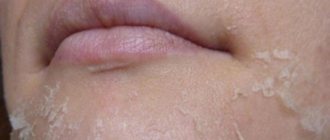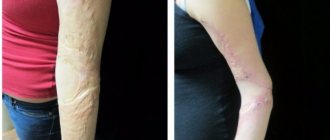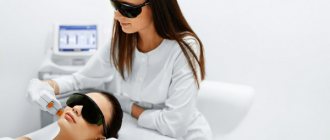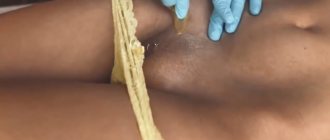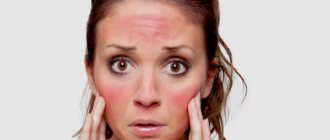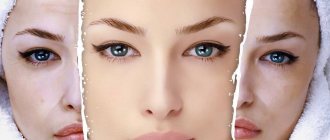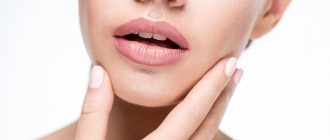Women turn to a cosmetology office to get rid of inflammatory formations and skin defects. And the more paradoxical is the fact that acne after peeling is a common occurrence.
This is a side effect caused by improperly performed cleaning, an allergic reaction, or low-quality post-procedure care. In some cases, the inflammation goes away on its own, in others it has to be treated with medication.
Why does a rash occur: the main reasons
Often, acne forms after a cosmetologist’s mistake; even a professional is not immune from it.
It is much easier to tolerate incorrect actions at home.
It is necessary to pay due attention to the skin, properly prepare it before peeling; if this is not done, acne will appear. Also, due to the fact that low-quality products are used for the procedure, acne or other problems may occur.
Perhaps this happened due to the individual characteristics of the body:
- It is possible to develop an allergic reaction to the components of the drug.
- These may be hormonal fluctuations that manifest as inflammatory reactions.
- The presence of undiagnosed diseases that manifested themselves after the procedure. Peeling is stressful for the body and skin. This contributes to a decrease in immunity.
- Adolescence, use of contraception, pregnancy, etc. can cause acne and other rashes.
Acne may also appear:
- with incorrectly selected means;
- after an incorrect action by people performing the procedure;
- due to non-compliance with all the recommendations of the cosmetologist.
After salicylic
The appearance of acne due to chemical exposure to the skin due to salicylic peeling is not a rare problem. This method of performing the procedure is considered very aggressive. If you do not follow the rules of the procedure and safety measures, then it is possible to cause enormous harm to the health of the skin. This type of peeling is harsh; there are safer methods of procedure for cleansing the skin.
Salicylic peeling is not recommended for women with sensitive skin.
The appearance of acne after salicylic peeling is a consequence of the fact that the preparation for the procedure was incorrect. This happens if the cosmetologist ignored checking the skin for the presence of demodex mites. There are also contraindications when chronic endocrine diseases are in the acute phase.
We recommend: 3 most popular types of peeling: what is better to apply to the face after each of these procedures?
After glycolic
Glycolic peeling can cause acne if the patient's skin is affected by demodicosis (this is a subcutaneous mite) or due to an allergic reaction.
After milk
Milk peeling is one of the most gentle methods. Pimples on sensitive skin can form if exposure to lactic acid acts as an allergen. The allergic skin rash should go away within a few days.
After yellow
After yellow peeling (also called retinoic peeling), acne rarely forms. This method of procedure is considered relatively safe and gentle. This procedure affects exclusively the upper layers of the epidermis. Therefore, in most cases, side effects are excluded. They can only occur if you completely ignore the rules that must be followed during the recovery period.
After acid
Fruit acid is irritating to the skin. Consequently, an inflammatory rash can very often appear on the face after an acid peel procedure.
In many cases, this problem should go away on its own after a few days. Only if the patient follows all the specialist’s recommendations.
Peeling and acne: do we treat or cripple?
Most types of peeling are designed to get rid of skin defects such as acne. Women decide to undergo chemical or hardware exfoliation in the hope of at least a year to forget about unpleasant inflammations, which often have to be hidden under powder or foundation. The good aesthetic results of peeling sessions are explained by the very mechanism of professional skin cleansing.
The basis of acid and physical procedures is the destruction of the keratinized epidermal layer and artificial stimulation of its deep renewal. Skin burned by chemical compounds or injured by small abrasives strives for rapid regeneration. In the inner layers of the dermis, the production of natural collagen and elastin fibers begins to double, blood circulation increases, and the skin easily absorbs nutrients and oxygen. Internal changes lead to the fact that dead epidermal cells slough off and are replaced by healthy and smooth skin. The rejuvenation caused by peeling from previous imperfections in appearance leaves no trace: wrinkles and unevenness disappear from the face, the tone is evened out, pigmentation becomes invisible or disappears completely.
Superficial and medium peels help get rid of acne, because their active components normalize the functioning of the sebaceous glands, open clogged pores, reduce the secretion of skin secretions and block the development of pathogenic microflora. Correctly selected exfoliation taking into account age and skin type helps a woman get rid of the “teenage” complex for a long time.
Any peeling, especially if it is performed for the first time, is stressful for the skin. The reaction of the skin to external irritation with chemicals or scrubs can be predictable and typical, but sometimes it can be unexpected and frightening.
Do not worry and rush to seek medical help if the following appears after peeling:
- peeling. Separation of the keratinized epidermis is the first result of peeling. The absence of such a result means that the procedure was performed or selected incorrectly. Therefore, peeling of the facial skin after peeling is the main and expected effect of exfoliation. How long the change of skin will continue depends on the depth of penetration of the active ingredients and the characteristics of the skin. Peeling within a week is considered normal. The main thing is not to interfere with the process and not to try to speed it up by scrubbing. Only patience will help you deal with dry scales without damaging your appearance. The skin will peel less after applying special care products;
- redness. The appearance of red areas on the face, especially after acid peeling, is nothing more than a chemical burn. Weak redness (I degree burn) means that the procedure was successful, intense redness accompanied by swelling (II degree burn) is a sign of overexposure of the peeling composition, an overly aggressive or incorrectly selected chemical agent. Redness may persist for up to 5 days, then the skin will begin to turn pale;
- swelling in the eye and neck area. Most often, swelling may appear after a medium peel on sensitive skin. But those with oily or combination skin are not immune to such a skin reaction. There is no need to worry about swelling; it usually subsides on its own within 2 days. Antihistamines will also help correct the situation.
Side effects of peeling include skin reactions to cleansing, such as:
- extensive pigmentation. The cause of the spread of brown pigment spots on young skin can only be exposure to ultraviolet radiation. During the recovery period of the skin after medium or deep peeling, they are protected from direct sunlight with special creams. This is a rule that is dangerous to break. It is also dangerous to perform serious acid peels in late spring or summer;
- scars and cicatrices. Skin thickening and scarring are guaranteed if you interfere with the natural course of its healing. Don’t touch dry crusts, don’t pick off the peelings, and this problem will go away;
- hives. This is an allergic reaction of the skin to a chemical peeling agent or micron particles of abrasives. A nettle rash may appear immediately after the procedure and spread instantly. Extensive pale pink or red blisters are very itchy and cause a lot of discomfort. Antihistamines and ointments will help alleviate the condition;
- acne. Pimples after peeling can appear for various reasons. The most common are an incorrectly selected procedure and careless attitude to post-peeling skin care. In addition, hidden skin infections and lack of preparation for exfoliation sessions can be the causes of painful and deep inflamed pustules.
Complications after peeling also include the appearance of papillomas, herpetic rashes, and exacerbation of dermatological diseases. Inappropriate exfoliation or disruption of the skin regeneration regime can also cause small pimples or pustules.
The main reasons why acne may appear after peelings are divided into three categories: cosmetic, dermatological and household. Fans of superficial and medial exfoliations turn to specialists with complaints of inflammatory rashes on the face. Pustular pustules can irritate the skin both with a light glycolic peel and as a result of a serious retinoic peel. So, let's find out why acne appears after peeling.
Cosmetic causes of acne:
- inappropriate exfoliation. Not all ages are susceptible to peelings. For example, young skin does not allow medium or deep exfoliation. Up to the age of 25, cosmetologists recommend getting rid of aesthetic imperfections only with the help of rare superficial techniques - soft fruit peelings or ultrasonic facial cleansing. More severe exfoliation at a young age will likely cause inflamed bumps to appear on the skin. Radical cleansing is allowed to be performed no earlier than 25-30 years. And only if there really is evidence for it;
- improper pre-peeling preparation is another cosmetic reason for the appearance of purulent pustules. On the eve of peeling, many experts advise preparing the skin for the procedure. How exactly depends on the type of skin and the cause of their imperfections. For example, for those with oily or combination skin with clogged and enlarged pores, comedones or acne, it is advisable to perform a manual or ultrasonic cleaning session 3-4 days before peeling. And for those who often suffer from herpes, take the antiviral drug Acyclovir a week before exfoliation;
- violation of post-peeling care rules. After peeling, acne may break out if a woman violates the protocol of care procedures. For example, in the first few days he touches his face, especially with dirty hands, picks off dry crusts, tries to disguise peeling with decorative cosmetics, does not cleanse the skin of the remnants of nourishing creams and masks;
An allergic reaction to a peeling drug or abrasive also results in a rash. Chemical exfoliation should be preceded by an allergy test for the components of the product. To do this, the specialist applies a drop of the composition to the thin skin of the inner bend of the elbow or under the knee. If no changes occur within 15 minutes, the peeling composition is suitable for you. Remind your cosmetologist about this before the procedure.
Dermatological causes of acne:
- infection of the skin by the Demodex mite. Before the exfoliation procedure, a woman may not be aware of the presence of this parasite in her body. Demodex develops in the sebaceous glands and hair follicles, causing extensive redness, inflammation and itchy ulcers. Subcutaneous mites can only provoke worsening of acne and furunculosis after peeling - the face takes on a terrible appearance, inflamed nodules do not go away for up to 2-3 weeks. Cosmetologists must prescribe tests for Demodex and Staphylococcus to patients before a course of peeling procedures. And in case of a positive result, carry out drug therapy;
- stress for the sebaceous glands. In response to an acid irritant, the sebaceous glands can increase secretion production. In this case, the next day after peeling, a pustular bump may appear on the face;
- hormonal imbalance associated with hormonal therapy, chronic diseases of the endocrine system or taking contraceptives.
Household causes of acne:
- visiting a bathhouse or sauna during the period of skin rehabilitation after exfoliation;
- physical activity that provokes increased sweating in the first 3-4 days after peeling.
What to do to get rid of the red rash?
If inflammation appears after peeling, then certain actions should be taken. They will contribute to the speedy restoration of the epithelium and help quickly get rid of the problem. It is also recommended to take into account mistakes that were made and led to bad consequences.
After the first signs of inflammation are detected, you should immediately seek help from a doctor. A qualified dermatologist or cosmetologist will help solve this problem.
The first signs are:
- When some areas of the skin began to change color. They can either lighten or darken.
- The entire skin of the face will turn red-violet.
- If a capillary network appears and becomes visible.
You should not self-medicate. Only an experienced specialist will correctly diagnose and prescribe the correct treatment. Self-medication is dangerous, it can be dangerous and have disastrous consequences. By taking the wrong actions, it is easy to compromise the health of the skin.
We recommend: Peeling after peeling. What to do if the skin is ripped off, and why can’t this be done?
You should definitely take into account the advice of a cosmetologist. It is possible that this is just a recovery period. Therefore, it will just take a little time to pass. In many cases, after a few days the skin takes on a healthy appearance on its own. The epidermis will return to order on its own only if you follow the recommendations.
Experts will draw up a list of actions necessary when acne appears. This is a whole complex of various procedures specifically aimed at the epithelium, affecting it comprehensively. The main thing here is to take into account the characteristics of the body, the cosmetics that were used, as well as the type of peeling. Then the treatment regimen will be drawn up correctly.
Methods to combat acne after peeling
The appearance of acne after cleansing your face is a reason to consult a dermatologist. This will help you quickly and effectively get rid of the problem.
Valuable recommendations:
- It is strictly forbidden to touch your face with your hands and remove ulcers yourself,
- It is better to disinfect the skin with Miramistin by wiping the skin with a cotton pad soaked in the preparation,
- affected areas should be treated with Zinerit or any other cream that contains Metronidazole
- It is recommended to take antiallergic drugs, carry out darsonvalization of the skin, lubricate the rash areas with zinc ointments,
- If a tick is detected, add a course of antibacterial therapy.
Treatment is carried out according to an individual scheme, strict adherence to which ensures recovery.
Pharmacy remedies for acne
In the treatment of acne, medications are necessarily used to help relieve inflammation and accelerate regeneration. For this it is recommended to use:
- Panthenol, as a well-proven wound healing agent,
- Chlorophyllipt solution, which disinfects the wound surface,
- Bepanten for wound healing,
- various lotions to soften the skin and relieve inflammation.
It is good to wash with Bioderma Sebium solution. All products must be used according to the instructions.
Basic treatment methods
Medication
The rash that appears should not be ignored and should be treated immediately. You should definitely consult a doctor to prescribe current medications. A specialist can find out the cause and choose the right methods to eliminate it. Only a cosmetologist or dermatologist can assess the condition of the skin, the depth of the rashes and their number and prescribe the necessary products.
The study found that if there is acne on the skin within a three-year period and it is not treated properly, then such neglect can lead to the formation of scars.
The use of the following drugs is recommended:
- The best ingredients in acne treatments are salicylic acid and benzoyl peroxide.
Benzoyl peroxide is great at killing bacteria that are inside the pore. It can reduce infection, as well as relieve redness and inflammation. Only this drug also has a negative effect, manifested by burning and dry skin. It is necessary to start treatment with a small concentration, so you can see the skin reaction. Salicylic acid also actively affects the problem. It removes bacteria and excess sebum from the pores. It can also cause reactions on sensitive skin - dryness and redness. - Antihistamines should be taken in cases where inflammatory processes were caused by exposure to any drug included in the peeling product.
- Skin disinfection is carried out with the drug “Miramistin”, gently wiping with cotton wool.
- It is recommended to treat the inflamed areas with Zenerit cream or any other cream that contains metronidazole.
- Zinc-based preparations are also considered effective.
- If the cause of the rash is a subcutaneous mite, then antiparasitic drugs and antibiotics are needed.
- You should take a course of live probiotics to support your immune system and improve digestion. These substances have a beneficial effect on skin health in the fight against acne.
Folk remedies
Under no circumstances should you squeeze pimples.
Folk remedies to combat acne are:
- Spot skin care using tea tree oil. It is used all over the world to fight acne as an antiseptic that actively fights bacteria and also heals wounds.
- Moisturizing the skin is done with products containing aloe vera.
Prevention
The occurrence of acne, caused by accelerated renewal of the epidermis after the peeling procedure, can be prevented as follows:
- Sleep at least 7-8 hours . It supports the immune system at its best and reduces stress levels, which directly affects the occurrence of acne.
- Regular exercise . It's a great way to control stress, and exercise also increases blood circulation and delivers important nutrients to the skin. But after playing sports, be sure to take a shower. Sweat can clog pores.
- Reduce carbohydrate intake . Carbohydrates cause an increase in glucose and insulin levels, this surge stimulates the appearance of acne.
- Correct skin cleansing system . Washing your face twice a day – morning and evening – is enough to remove bacteria. Frequent washing can lead to dryness and irritation. However, using hot water with hard brushes is not the best option.
- Moderate amount of makeup . The fewer products you apply to your skin, the better. Use cosmetics and sunscreens labeled “oil free,” “water-based,” or “non-comedogenic.” It is important to completely remove makeup before going to bed.
Other methods of preventing acne that are not caused by the process of cleansing the skin after peeling include:
- Analysis of peeling ingredients to determine possible allergens.
- Limiting face contact with hands or other objects, such as a phone.
- Selection of the right facial care according to skin type and condition.
Preventive measures
Since this procedure violates the integrity of the skin, it is necessary to strictly follow the rules before and after the procedure:
- You should carefully select your peeling and take all necessary precautions after each procedure.
- It is not recommended to touch defenseless skin with your hands to avoid infection.
- You cannot remove skin flakes yourself.
- Proper facial care is necessary.
- You should not use aggressive agents or inappropriate creams.
- It is necessary to give up decorative cosmetics, otherwise the process of cell regeneration will slow down.
- After this procedure, you cannot visit a sauna, a swimming pool with chlorinated water, or a bathhouse.
- Heavy physical activity is not recommended. This causes excessive sweating and may increase the risk of complications.
- When going outside in cloudless weather, you should apply products that protect against UV radiation. And reduce your time in the sun as much as possible. Avoid direct exposure to sunlight. The epithelium will be deprived of protection after peeling, and you can get sunburn.
- Avoid using scrubs.
So that such a nuisance as acne does not come as a surprise to you, you should follow simple rules. Then you will get glowing skin instead of a face full of acne. You just need to listen to the advice and recommendations, then serious problems will not arise, and the skin will heal much faster and remain healthy.
Almond peeling
Of course, acne after peeling can upset every girl. However, the likelihood of their occurrence after a gentle procedure is much less. This is true for almond peeling. During the treatment process, preparations are used that are made on a basis that is safe for skin health. Therefore, rashes in this case are practically excluded.
The almond base, unlike other types of compositions, does not remove the top layer of the epidermis. It does not cleanse the deep layers of the dermis. This procedure is indicated for young girls who have relevant skin problems. Almond peeling is allowed even in the presence of visible inflammation on the skin.
The only reason why rashes may appear after such a procedure may be the penetration of infection into the epidermis. In this case, the treatment regimen is prescribed by the doctor based on the characteristics of the patient’s body and the causes of the pathology.
How does Jessner peel work?
Here are some of the main benefits of the Jessner Peel:
- Exfoliates dead skin cells and helps smooth out various fine lines and wrinkles;
- It can reduce the appearance of acne scars;
- May reduce the appearance of large pores;
- May improve overall complexion;
- In some cases, it can lighten areas of skin discoloration;
- May help ease inflammation and reduce acne;
- Helps in the treatment of melanoma;
- Restores skin to a healthier, more youthful tone;
- May act as a customized treatment for more extensive skin damage.
The Jessner Peel is made up of three main ingredients. These ingredients work in parallel to relax the outer layers of skin by breaking down dead skin cells. This treatment promotes a natural exfoliation that begins a few days after the chemical treatment. At the beauty salon, your skin is thoroughly cleansed and then exfoliating chemicals are applied. dead areas of skin As a rule, to achieve the best results, as many as 2 - 5 layers of skin are removed. Typically, a light moisturizer or soothing mask is applied to the skin at the end of the procedure.
If necessary, the Jessner peel can be repeated every four weeks until the desired results are achieved, however most patients require only one treatment.
